The In-Situ Quantification of Structural Radiation Damage in Zircon Using Laser-Induced Confocal Photoluminescence Spectroscopy
Abstract
1. Introduction
2. Materials and Methods
2.1. Samples
2.2. Photoluminescence and Raman Spectroscopy
2.3. Trace-Element Analyses and U-Pb Geochronology
3. Results and Discussion
3.1. Zircon’s Amorphous Fraction Decoded from Dy photoluminescence
3.2. Sri Lankan Zircon as Reference for the Verification of the PL-Based Estimation of the Amorphous Fraction
3.3. PL Photoluminescence Compared to Raman Spectroscopy
4. Summary and Conclusions
Author Contributions
Funding
Acknowledgments
Conflicts of Interest
Appendix A
| Sample | U * [ppm] | Th * [ppm] | 206Pb/238U Age * [Ma] | Calc. α-dose † [×1018 events/g] | Amorphous Fraction ‡ fa [%] |
|---|---|---|---|---|---|
| CZ3 | 550 ± 10 | 30 ± 2 | 563.9 ± 1.3 | 1.05–1.10 | 21.8 |
| B188 | 556 ± 24 | 59 ± 4 | 559 ± 8 | 1.03–1.15 | 25.8 |
| BR1 | 796 ± 13 | 39 ± 1 | 558 ± 13 | 1.47–1.60 | 36.2 |
| BR231 | 772 ± 10 | 109 ± 2 | 571 ± 4 | 1.53–1.59 | 39.7 |
| M257 | 840 ± 27 | 235 ± 20 | 561.3 ± 0.3 | 1.66–1.78 | 37.1 |
| BR266 | 909 ± 17 | 201 ± 7 | 559.0 ± 0.3 | 1.77–1.88 | 37.5 |
| M146 | 923 ± 17 | 411 ± 9 | 567 ± 4 | 1.92–2.03 | 44.6 |
| M127 | 923 ± 23 | 439 ± 11 | 524.3 ± 0.4 | 1.78–1.88 | 43.4 |
| OR1 | 1490 ± 70 | 279 ± 18 | 522 ± 3 | 2.62–2.92 | 54.6 |
| G168 | 1499 ± 33 | 257 ± 9 | 547 ± 3 | 2.83–3.00 | 58.4 |
| G4 | 2355 ± 84 | 330 ± 12 | 564 ± 5 | 4.48–4.91 | 76.0 |
| G3 | 2572 ± 96 | 585 ± 34 | 542 ± 5 | 4.77–5.25 | 76.3 |
| N17 | 5568 ± 114 | 344 ± 45 | 551 ± 7 | 10.27–11.02 | 97.4 |
| Rata | 140 ± 100 | 90 ± 80 | 1.2 ± 0.3 | ±0 | 0.0 |
| Samples | U [ppm] | Th [ppm] | Calc. α-dose † [×1018 events/g] | fa ‡ [%] |
|---|---|---|---|---|
| Sample SL1 | ||||
| SL1u_01 | 3146 | 2520 | 6.66 | 84.5 |
| SL1u_02 | 4185 | 3519 | 8.93 | 94.4 |
| SL1u_03 | 4269 | 3622 | 9.13 | 90.2 |
| SL1u_06 | 679 | 195 | 4.06 | 33.3 |
| SL1u_07 | 1161 | 107 | 3.45 | 39.1 |
| SL1u_08 | 1807 | 118 | 1.30 | 58.6 |
| SL1u_09 | 1806 | 1182 | 2.12 | 62.3 |
| SL1u_10 | 1988 | 1211 | 3.28 | 69.1 |
| SL1u_11 | 1538 | 753 | 3.72 | 56.1 |
| Sample SL2 | ||||
| SL2u_1 | 1271 | 710 | 4.53 | 69.8 |
| SL2u_2 | 1010 | 341 | 3.54 | 60.7 |
| SL2u_3 | 929 | 512 | 1.67 | 38.2 |
| SL2u_4 | 940 | 430 | 1.77 | 42.8 |
| SL2u_5 | 538 | 216 | 0.97 | 27.6 |
| SL2u_6 | 660 | 339 | 1.14 | 31.2 |
| SL2u_7 | 435 | 168 | 1.21 | 34.5 |
| SL2u_8 | 444 | 134 | 0.85 | 24.4 |
| MalawiX | ||||
| MalawiXu_01 | 356 | 7934 | 0.81 | 37.5 |
| MalawiXu_02 | 151 | 10,041 | 0.92 | 38.8 |
| MalawiXu_03 | 364 | 19,465 | 1.80 | 54.3 |
| MalawiXu_04 | 921 | 6018 | 0.85 | 35.4 |
| MalawiXu_05 | 4543 | 5704 | 2.14 | 66.5 |
| MalawiXu_06 | 586 | 13,959 | 1.41 | 45.8 |
| MalawiXu_07 | 92 | 9289 | 0.83 | 32.7 |
| MalawiXu_08 | 146 | 10,788 | 0.98 | 44.0 |
| MalawiXu_09 | 244 | 10,138 | 0.96 | 38.9 |
| MalawiXu_10 | 4744 | 5841 | 2.23 | 65.8 |
| MalawiXu_11 | 142 | 80 | 0.06 | 0.0 |
| MalawiXu_12 | 5153 | 4174 | 2.23 | 60.7 |
| MalawiXu_13 | 5682 | 7105 | 2.68 | 71.8 |
| MalawiA | ||||
| MalawiAu_1 | 112 | 366 | 0.07 | 2.2 |
| MalawiAu_2 | 130 | 320 | 0.08 | 7.4 |
| MalawiAu_3 | 113 | 328 | 0.07 | 0.0 |
| MalawiAu_4 | 119 | 369 | 0.08 | 0.1 |
| MalawiAu_5 | 106 | 308 | 0.07 | 0.0 |
| MalawiAu_6 | 157 | 1021 | 0.15 | 5.7 |
| MalawiAu_7 | 146 | 1272 | 0.16 | 7.6 |
| Analysis Spot | Isotope Ratios | Ages [Ma] | ||||
|---|---|---|---|---|---|---|
| 207Pb/235U | ±2σ | 206Pb/238U | ±2σ | 206Pb/238U | ±2σ | |
| SL1u_01 | 0.66538 | 0.0095 | 0.08358 | 0.0009 | 517.5 | 5 |
| SL1u_02 | 0.66448 | 0.0095 | 0.08265 | 0.0009 | 511.9 | 5 |
| SL1u_03 | 0.66548 | 0.0096 | 0.08215 | 0.0009 | 509 | 5 |
| SL1u_04 | 0.68775 | 0.0105 | 0.08635 | 0.0009 | 533.9 | 6 |
| SL1u_05 | 0.67741 | 0.0196 | 0.08371 | 0.0012 | 518.3 | 7 |
| SL1u_06 | 0.70231 | 0.0128 | 0.08794 | 0.0010 | 543.4 | 6 |
| SL1u_07 | 0.72313 | 0.0127 | 0.08796 | 0.0010 | 543.5 | 6 |
| SL1u_08 | 0.70412 | 0.0124 | 0.08756 | 0.0010 | 541.1 | 6 |
| SL1u_09 | 0.70172 | 0.0126 | 0.08616 | 0.0010 | 532.8 | 6 |
| SL1u_10 | 0.69688 | 0.0128 | 0.08493 | 0.0010 | 525.5 | 6 |
| SL1u_11 | 0.69829 | 0.0133 | 0.08736 | 0.0010 | 539.9 | 6 |
| Unannealed half (u) weighted mean age and 95% confidence 528 ± 9 Ma (n = 11, MSWD = 22) | ||||||
| SL1a_01 | 0.65196 | 0.0094 | 0.08144 | 0.0009 | 504.7 | 5 |
| SL1a_02 | 0.66218 | 0.0097 | 0.08288 | 0.0009 | 513.3 | 5 |
| SL1a_03 | 0.65626 | 0.0098 | 0.08246 | 0.0009 | 510.8 | 5 |
| SL1a_04 | 0.65840 | 0.0100 | 0.08242 | 0.0009 | 510.5 | 5 |
| SL1a_05 | 0.67128 | 0.0106 | 0.08305 | 0.0009 | 514.3 | 5 |
| SL1a_06 | 0.69062 | 0.0125 | 0.08608 | 0.0010 | 532.3 | 6 |
| SL1a_07 | 0.68726 | 0.0123 | 0.08667 | 0.0010 | 535.8 | 6 |
| SL1a_08 | 0.67132 | 0.0117 | 0.08431 | 0.0010 | 521.8 | 6 |
| SL1a_09 | 0.68369 | 0.0124 | 0.08582 | 0.0010 | 530.8 | 6 |
| SL1a_10 | 0.67936 | 0.0126 | 0.08466 | 0.0010 | 523.9 | 6 |
| SL1a_11 | 0.68950 | 0.0133 | 0.08637 | 0.0010 | 534 | 6 |
| Annealed half (a) weighted mean age and 95% confidence 520 ± 7 Ma (n = 11, MSWD = 16) | ||||||
| Both SL1 halves weighted mean age and 95% confidence 524 ± 6 Ma (n = 22, MSWD = 20) | ||||||
| Analysis Spot | Isotope Ratios | Ages [Ma] | ||||
|---|---|---|---|---|---|---|
| 207Pb/235U | ±2σ | 206Pb/238U | ±2σ | 206Pb/238U | ±2σ | |
| SL2u_1 | 1.14580 | 0.0276 | 0.09145 | 0.0012 | 564.1 | 7 |
| SL2u_2 | 0.74978 | 0.0187 | 0.08678 | 0.0012 | 536.5 | 7 |
| SL2u_3 | 0.71283 | 0.0190 | 0.08556 | 0.0012 | 529.2 | 7 |
| SL2u_4 | 0.66528 | 0.0179 | 0.08574 | 0.0012 | 530.3 | 7 |
| SL2u_5 | 0.63846 | 0.0224 | 0.08431 | 0.0014 | 521.8 | 8 |
| SL2u_6 | 0.64443 | 0.0194 | 0.08452 | 0.0012 | 523.1 | 7 |
| SL2u_7 | 0.64826 | 0.0189 | 0.08441 | 0.0012 | 522.4 | 7 |
| SL2u_8 | 0.64051 | 0.0199 | 0.08371 | 0.0012 | 518.2 | 7 |
| Unannealed half (u) weighted mean age and 95% confidence 531 ± 12 Ma (n = 8, MSWD = 17) | ||||||
| SL2a_1 | 0.66047 | 0.0163 | 0.08327 | 0.0011 | 515.6 | 7 |
| SL2a_2 | 0.68370 | 0.0178 | 0.08262 | 0.0011 | 511.7 | 7 |
| SL2a_3 | 0.66219 | 0.0173 | 0.08324 | 0.0011 | 515.5 | 7 |
| SL2a_4 | 0.64247 | 0.0170 | 0.08363 | 0.0011 | 517.8 | 7 |
| SL2a_5 | 0.64947 | 0.0190 | 0.08284 | 0.0012 | 513.1 | 7 |
| SL2a_6 | 0.63462 | 0.0181 | 0.08340 | 0.0012 | 516.4 | 7 |
| SL2a_7 | 0.62665 | 0.0193 | 0.08211 | 0.0012 | 508.7 | 7 |
| SL2a_8 | 0.62965 | 0.0196 | 0.08197 | 0.0012 | 507.9 | 7 |
| Annealed half (a) weighted mean age and 95% confidence 514 ± 3 Ma (n = 8, MSWD = 1.1) | ||||||
| Both SL2 halves weighted mean age and 95% confidence 522 ± 7 Ma (n = 16, MSWD = 15) | ||||||
| Analysis Spot | Isotope Ratios | Ages [Ma] | ||||
|---|---|---|---|---|---|---|
| 207Pb/235U | ±2σ | 206Pb/238U | ±2σ | 206Pb/238U | ±2σ | |
| MalawiXu_01 | 0.11931 | 0.0064 | 0.01724 | 0.0003 | 110.2 | 2 |
| MalawiXu_02 | 1.28105 | 0.0332 | 0.02791 | 0.0005 | 177.5 | 3 |
| MalawiXu_03 | 0.12040 | 0.0057 | 0.01786 | 0.0003 | 114.1 | 2 |
| MalawiXu_04 | 0.12048 | 0.0039 | 0.01746 | 0.0003 | 111.6 | 2 |
| MalawiXu_05 | 0.11512 | 0.0026 | 0.01723 | 0.0002 | 110.1 | 1 |
| MalawiXu_06 | 0.13647 | 0.0125 | 0.01847 | 0.0006 | 118 | 4 |
| MalawiXu_07 | 0.13201 | 0.0129 | 0.01867 | 0.0005 | 119.2 | 3 |
| MalawiXu_08 | 0.64319 | 0.0299 | 0.02312 | 0.0006 | 147.3 | 4 |
| MalawiXu_09 | 0.39492 | 0.0155 | 0.02027 | 0.0004 | 129.4 | 3 |
| MalawiXu_10 | 0.11054 | 0.0033 | 0.01750 | 0.0003 | 111.9 | 2 |
| MalawiXu_11 | 0.11505 | 0.0106 | 0.01755 | 0.0005 | 112.2 | 3 |
| MalawiXu_12 | 0.11067 | 0.0042 | 0.01768 | 0.0003 | 113 | 2 |
| MalawiXu_13 | 0.10788 | 0.0040 | 0.01752 | 0.0003 | 112 | 2 |
| Unannealed half (u) weighted mean age and 95% confidence 112 ± 1.3 Ma (n = 9, MSWD = 3.4) | ||||||
| MalawiXa_01 | 0.11786 | 0.0048 | 0.01719 | 0.0003 | 109.9 | 2 |
| MalawiXa_02 | 0.56436 | 0.0187 | 0.02105 | 0.0004 | 134.3 | 3 |
| MalawiXa_03 | 0.12354 | 0.0059 | 0.01768 | 0.0003 | 113 | 2 |
| MalawiXa_04 | 0.11648 | 0.0034 | 0.01718 | 0.0002 | 109.8 | 1 |
| MalawiXa_05 | 0.11360 | 0.0025 | 0.01674 | 0.0002 | 107 | 1 |
| MalawiXa_06 | 0.11761 | 0.0062 | 0.01762 | 0.0003 | 112.6 | 2 |
| MalawiXa_07 | 0.96149 | 0.0429 | 0.02496 | 0.0008 | 158.9 | 5 |
| MalawiXa_08 | 0.47604 | 0.0181 | 0.02046 | 0.0004 | 130.6 | 3 |
| MalawiXa_09 | 0.20788 | 0.0105 | 0.01869 | 0.0004 | 119.4 | 3 |
| MalawiXa_10 | 0.11153 | 0.0034 | 0.01736 | 0.0003 | 111 | 2 |
| MalawiXa_11 | 0.10686 | 0.0091 | 0.01774 | 0.0005 | 113.3 | 3 |
| MalawiXa_12 | 0.11335 | 0.0043 | 0.01721 | 0.0003 | 110 | 2 |
| MalawiXa_13 | 0.10592 | 0.0038 | 0.01719 | 0.0003 | 109.8 | 2 |
| Annealed half (a) weighted mean age and 95% confidence 110 ± 1.6 Ma (n = 9, MSWD = 5.4) | ||||||
| Both halves weighted mean age and 95% confidence 111± 1 Ma (n = 18, MSWD = 5.2) | ||||||
| Analysis Spot | Isotope Ratios | Ages [Ma] | ||||
|---|---|---|---|---|---|---|
| 207Pb/235U | ±2σ | 206Pb/238U | ±2σ | 206Pb/238U | ±2σ | |
| MalawiAu_1 | 0.29315 | 0.0171 | 0.01915 | 0.0005 | 122.3 | 3 |
| MalawiAu_2 | 0.12101 | 0.0108 | 0.01715 | 0.0005 | 109.6 | 3 |
| MalawiAu_3 | 0.25611 | 0.0164 | 0.01857 | 0.0005 | 118.6 | 3 |
| MalawiAu_4 | 0.20370 | 0.0143 | 0.01885 | 0.0005 | 120.4 | 3 |
| MalawiAu_5 | 1.70162 | 0.0543 | 0.03181 | 0.0008 | 201.8 | 5 |
| MalawiAu_6 | 0.13262 | 0.0102 | 0.01797 | 0.0005 | 114.8 | 3 |
| MalawiAu_7 | 0.15708 | 0.0113 | 0.01784 | 0.0005 | 114 | 3 |
| MalawiAa_1 | 0.22444 | 0.0126 | 0.01900 | 0.0005 | 121.4 | 3 |
| MalawiAa_2 | 0.19624 | 0.0133 | 0.01791 | 0.0005 | 114.4 | 3 |
| MalawiAa_3 | 0.17784 | 0.0129 | 0.01756 | 0.0005 | 112.2 | 3 |
| MalawiAa_4 | 0.25748 | 0.0156 | 0.01898 | 0.0005 | 121.2 | 3 |
| MalawiAa_5 | 1.97138 | 0.0592 | 0.03390 | 0.0008 | 214.9 | 5 |
| MalawiAa_6 | 0.28709 | 0.0153 | 0.01926 | 0.0005 | 123 | 3 |
| MalawiAa_7 | 0.55253 | 0.0245 | 0.02151 | 0.0006 | 137.2 | 4 |
| Element Concentrations [ppm] | 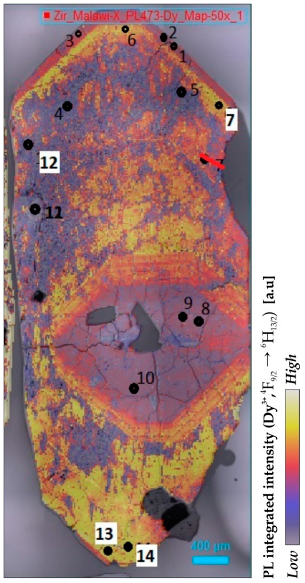 | ||||||||||||||
| Spot: | 1 | 2 | 3 | 4 | 5 | 6 | 7 | 8 | 9 | 10 | 11 | 12 | 13 | 14 | |
| Hf | 1.22 | 1.29 | 1.32 | 0.98 | 1.00 | 1.07 | 1.06 | 0.45 | 0.44 | 0.44 | 1.02 | 1.00 | 0.99 | 0.97 | |
| P | 1654 | 1528 | 1533 | 2083 | 1170 | 1002 | 942 | 377 | 395 | 388 | 992 | 838 | 982 | 933 | |
| Ca | <51 | <43 | <43 | 823 | 259 | <45 | <41 | <46 | 59 | <46 | 160 | <46 | 49 | <46 | |
| Ti | 2 | 2 | 1 | 63 | 24 | 6 | 5 | 5 | 6 | 5 | 11 | 10 | 4 | 6 | |
| Fe | 275 | 496 | 321 | 5612 | 7886 | 711 | 369 | 333 | 282 | 229 | 10938 | 2016 | 154 | 172 | |
| Nb | 750 | 857 | 881 | 2311 | 1187 | 924 | 958 | 413 | 424 | 399 | 425 | 1014 | 734 | 835 | |
| Ta | 273 | 355 | 398 | 44 | 44 | 73 | 73 | 63 | 62 | 63 | 17 | 56 | 54 | 50 | |
| Pb | 27 | 29 | 30 | 18 | 21 | 15 | 14 | 307 | 294 | 330 | 22 | 19 | 17 | 20 | |
| Th | 5522 | 8648 | 9948 | 16,946 | 15,496 | 15,408 | 13,449 | 5438 | 5202 | 5811 | 7222 | 15,230 | 17,873 | 21,653 | |
| U | 382 | 412 | 434 | 220 | 252 | 205 | 205 | 4492 | 4330 | 4842 | 161 | 253 | 255 | 303 | |
| Y | 20,045 | 19,667 | 19,561 | 9670 | 10,002 | 22,853 | 22,737 | 13,300 | 13,276 | 13,308 | 14,084 | 23,187 | 22,649 | 23,861 | |
| La | 1 | 0 | 1 | 376 | 67 | 1 | 0 | 0 | 0 | 0 | 7 | 5 | 0 | 0 | |
| Ce | 318 | 285 | 280 | 181 | 152 | 524 | 550 | 226 | 232 | 241 | 237 | 621 | 615 | 698 | |
| Pr | 0 | 0 | 1 | 62 | 14 | 3 | 2 | 1 | 1 | 2 | 3 | 5 | 3 | 6 | |
| Nd | 5 | 4 | 8 | 240 | 67 | 67 | 55 | 26 | 25 | 31 | 30 | 83 | 75 | 120 | |
| Sm | 19 | 22 | 25 | 107 | 76 | 252 | 230 | 96 | 93 | 106 | 104 | 288 | 287 | 379 | |
| Eu | 4 | 5 | 5 | 13 | 12 | 43 | 41 | 17 | 16 | 18 | 19 | 49 | 49 | 62 | |
| Gd | 172 | 192 | 202 | 363 | 372 | 1356 | 1298 | 627 | 621 | 665 | 578 | 1437 | 1475 | 1724 | |
| Tb | 93 | 96 | 99 | 104 | 112 | 372 | 363 | 196 | 194 | 204 | 177 | 386 | 391 | 429 | |
| Dy | 1443 | 1434 | 1441 | 1055 | 1125 | 3287 | 3266 | 2007 | 1989 | 2065 | 1746 | 3361 | 3384 | 3540 | |
| Ho | 567 | 552 | 550 | 299 | 314 | 774 | 769 | 514 | 509 | 522 | 469 | 781 | 769 | 783 | |
| Er | 2879 | 2744 | 2716 | 1142 | 1207 | 2447 | 2474 | 1587 | 1579 | 1584 | 1759 | 2474 | 2377 | 2403 | |
| Tm | 618 | 586 | 582 | 195 | 205 | 361 | 368 | 211 | 209 | 205 | 306 | 365 | 347 | 343 | |
| Yb | 4771 | 4488 | 4528 | 1315 | 1409 | 2195 | 2259 | 1130 | 1121 | 1068 | 2165 | 2228 | 2099 | 2051 | |
| Lu | 530 | 506 | 512 | 142 | 155 | 217 | 223 | 100 | 100 | 94 | 244 | 223 | 201 | 196 | |
| REEs [wt %] | 3.15 | 3.06 | 3.05 | 1.53 | 1.53 | 3.47 | 3.46 | 2.04 | 1.99 | 2.01 | 2.19 | 3.55 | 3.47 | 3.66 | |
| Element Concentrations [ppm] | 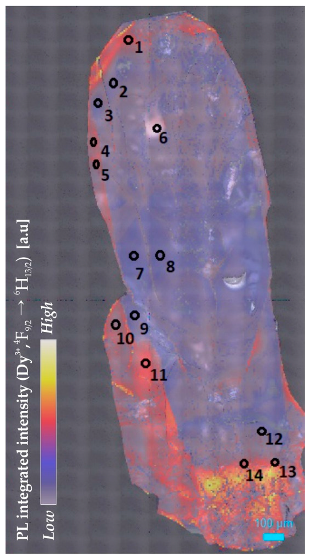 | ||||||||||||||
| Spot: | 1 | 2 | 3 | 4 | 5 | 6 | 7 | 8 | 9 | 10 | 11 | 12 | 13 | 14 | |
| Hf | 1.26 | 1.12 | 1.12 | 1.18 | 1.16 | 1.07 | 1.06 | 1.07 | 1.08 | 1.12 | 1.15 | 1.18 | 1.17 | 1.19 | |
| P | 74 | 65 | 66 | 75 | 68 | 60 | 68 | 55 | 50 | 87 | 68 | 64 | 89 | 139 | |
| Ca | <72 | <67 | 52 | 65 | 58 | <63 | <71 | <68 | <65 | <62 | <62 | <61 | <64 | <62 | |
| Ti | 9 | 74 | 56 | 4 | 2 | 112 | 151 | 163 | 166 | 3 | 4 | 70 | 73 | 56 | |
| Fe | 91 | 104 | 58 | 130 | 201 | 131 | 84 | 119 | 82 | 85 | 31 | 142 | 252 | 378 | |
| Nb | 417 | 1241 | 952 | 556 | 529 | 1680 | 1371 | 1376 | 1395 | 682 | 754 | 1272 | 2107 | 1592 | |
| Ta | 7 | 18 | 14 | 7 | 7 | 18 | 26 | 27 | 25 | 13 | 16 | 20 | 8 | 6 | |
| Pb | 9 | 10 | 10 | 10 | 10 | 11 | 9 | 9 | 9 | 9 | 8 | 10 | 11 | 13 | |
| Th | 3004 | 1140 | 1190 | 534 | 516 | 691 | 387 | 349 | 361 | 303 | 255 | 3130 | 1392 | 1521 | |
| U | 125 | 152 | 147 | 146 | 151 | 155 | 133 | 130 | 128 | 136 | 128 | 148 | 159 | 181 | |
| Y | 10679 | 8476 | 9171 | 15528 | 15777 | 9551 | 8779 | 7959 | 6632 | 15063 | 11650 | 9013 | 8074 | 9777 | |
| La | 11 | 251 | 139 | 21 | 10 | 599 | 1006 | 1335 | 1771 | 24 | 51 | 412 | 178 | 98 | |
| Ce | 2509 | 7105 | 6079 | 1702 | 1454 | 6695 | 7809 | 8226 | 7248 | 2073 | 2155 | 9878 | 7130 | 6424 | |
| Pr | 157 | 931 | 736 | 124 | 95 | 900 | 965 | 957 | 942 | 133 | 154 | 1491 | 1438 | 895 | |
| Nd | 1325 | 4756 | 4353 | 1033 | 880 | 3782 | 3556 | 3337 | 3056 | 1060 | 1084 | 7507 | 11552 | 9947 | |
| Sm | 715 | 1107 | 1216 | 689 | 657 | 911 | 717 | 604 | 517 | 659 | 557 | 1725 | 3557 | 5460 | |
| Eu | 58 | 68 | 77 | 62 | 62 | 58 | 44 | 37 | 30 | 58 | 43 | 101 | 185 | 326 | |
| Gd | 1054 | 874 | 998 | 1076 | 1074 | 789 | 599 | 502 | 409 | 941 | 696 | 1399 | 2050 | 3525 | |
| Tb | 215 | 148 | 168 | 242 | 244 | 147 | 113 | 95 | 78 | 201 | 146 | 225 | 264 | 434 | |
| Dy | 1578 | 1039 | 1155 | 1960 | 1972 | 1098 | 907 | 798 | 655 | 1652 | 1228 | 1464 | 1442 | 2123 | |
| Ho | 350 | 239 | 255 | 471 | 482 | 271 | 239 | 218 | 182 | 422 | 330 | 303 | 273 | 361 | |
| Er | 1122 | 891 | 935 | 1764 | 1782 | 1026 | 980 | 919 | 778 | 1708 | 1369 | 985 | 846 | 1033 | |
| Tm | 193 | 169 | 175 | 332 | 339 | 198 | 199 | 189 | 160 | 335 | 278 | 169 | 146 | 165 | |
| Yb | 1495 | 1390 | 1428 | 2711 | 2755 | 1652 | 1698 | 1625 | 1378 | 2804 | 2377 | 1303 | 1118 | 1211 | |
| Lu | 174 | 167 | 172 | 314 | 320 | 195 | 207 | 200 | 172 | 332 | 287 | 151 | 132 | 141 | |
| REEs [wt %] | 2.16 | 2.76 | 2.71 | 2.80 | 2.79 | 2.79 | 2.78 | 2.70 | 2.40 | 2.75 | 2.24 | 3.61 | 3.84 | 4.19 | |
| Element Concentrations [ppm] | |||||||||||||
|---|---|---|---|---|---|---|---|---|---|---|---|---|---|
| Spot: | 1 | 2 | 3 | 4 | 5 | 6 | 7 | 8 | 9 | 10 | 11 | 12 | 13 |
| Hf | 0.79 | 0.78 | 0.80 | 0.63 | 0.62 | 0.64 | 0.64 | 0.78 | 0.75 | 0.72 | 0.98 | 0.70 | 0.80 |
| P | 30 | 33 | 25 | 42 | 41 | 44 | 47 | 47 | 76 | 34 | 46 | 43 | 27 |
| Ca | <55 | <58 | <60 | <57 | <59 | <56 | <55 | <59 | <66 | <57 | <66 | <70 | <60 |
| Ti | 4.7 | 4.3 | 4.5 | 6.3 | 6.1 | 5.1 | 5.2 | 7.8 | 24.0 | 6.7 | 4.8 | 5.6 | 5.5 |
| Fe | <2 | <2 | <2 | <2 | <2 | <2 | <2 | <2 | <2 | 47 | 47 | 7 | <3 |
| Nb | 0.6 | 0.6 | 0.4 | 0.7 | 0.7 | 0.8 | 0.8 | 0.8 | 1.7 | 0.5 | 0.4 | 0.5 | 0.6 |
| Ta | 0.1 | 0.1 | 0.1 | 0.6 | 0.5 | 0.5 | 0.4 | 0.4 | 0.4 | 0.1 | 0.0 | 0.2 | 0.2 |
| Pb | 161 | 160 | 161 | 178 | 169 | 227 | 225 | 220 | 156 | 215 | 66 | 273 | 106 |
| Th | 158 | 171 | 132 | 164 | 152 | 204 | 204 | 243 | 176 | 325 | 37 | 452 | 66 |
| U | 498 | 492 | 500 | 541 | 515 | 691 | 675 | 667 | 483 | 663 | 206 | 843 | 323 |
| Y | 459 | 475 | 449 | 128 | 117 | 150 | 150 | 156 | 490 | 514 | 85 | 530 | 87 |
| La | b.d. | b.d. | 0.003 | 0.09 | b.d. | 0.005 | 0.005 | 0.002 | 0.38 | 0.04 | 0.01 | 0.03 | 0.005 |
| Ce | 2.4 | 2.5 | 2.2 | 1.7 | 1.7 | 2.2 | 2.2 | 2.2 | 157.4 | 2.3 | 3.7 | 2.3 | 2.1 |
| Pr | b.d. | 0.02 | 0.03 | 0.02 | b.d. | 0.02 | 0.01 | 0.01 | 0.24 | 0.08 | b.d. | 0.09 | b.d. |
| Nd | 0.3 | 0.4 | 0.4 | 0.2 | 0.2 | 0.4 | 0.1 | 0.3 | 1.9 | 1.4 | b.d. | 1.5 | 0.1 |
| Sm | 1.1 | 1.1 | 0.9 | 0.4 | 0.3 | 0.5 | 0.6 | 0.6 | 1.6 | 2.7 | 0.2 | 2.9 | 0.3 |
| Eu | 0.3 | 0.4 | 0.3 | 0.1 | 0.1 | 0.1 | 0.2 | 0.2 | 1.1 | 0.8 | 0.1 | 0.6 | 0.1 |
| Gd | 6.8 | 6.8 | 6.7 | 1.8 | 1.8 | 2.7 | 2.3 | 2.9 | 9.1 | 10.4 | 0.9 | 10.9 | 1.1 |
| Tb | 2.3 | 2.4 | 2.3 | 0.7 | 0.6 | 0.8 | 0.8 | 0.8 | 2.8 | 3.1 | 0.4 | 3.2 | 0.4 |
| Dy | 32 | 33 | 30 | 9 | 8 | 10 | 10 | 11 | 37 | 40 | 5 | 41 | 6 |
| Ho | 13 | 14 | 13 | 4 | 3 | 4 | 4 | 5 | 15 | 15 | 2 | 16 | 3 |
| Er | 73 | 74 | 71 | 20 | 19 | 23 | 23 | 24 | 75 | 80 | 14 | 82 | 14 |
| Tm | 18 | 18 | 18 | 5 | 5 | 6 | 6 | 6 | 19 | 19 | 4 | 20 | 4 |
| Yb | 188 | 193 | 186 | 55 | 52 | 64 | 61 | 66 | 195 | 199 | 44 | 204 | 40 |
| Lu | 33 | 34 | 32 | 10 | 10 | 11 | 11 | 12 | 34 | 35 | 9 | 36 | 7 |
| REEs [ppm] | 829 | 854 | 811 | 236 | 218 | 276 | 271 | 287 | 1038 | 922 | 168 | 950 | 164 |
References
- Pabst, A. The metamict state. Am. Mineral. J. Earth Planet. Mater. 1952, 37, 137–157. [Google Scholar]
- Ewing, R.C. The metamict state: 1993—The centennial. Nucl. Instrum. Methods Phys. Res. Sect. B Beam Interact. Mater. At. 1994, 91, 22–29. [Google Scholar] [CrossRef]
- Nasdala, L.; Grambole, D.; Ruschel, K. Review of effects of radiation damage on the luminescence emission of minerals, and the example of He-irradiated CePO4. Mineral. Petrol. 2013, 107, 441–454. [Google Scholar] [CrossRef]
- Weber, W.J. Radiation-induced defects and amorphization in zircon. J. Mater. Res. 1990, 5, 2687–2697. [Google Scholar] [CrossRef]
- Trachenko, K.O.; Dove, M.T.; Salje, E.K. Atomistic modelling of radiation damage in zircon. J. Phys. Condens. Matter 2001, 13, 1947. [Google Scholar] [CrossRef]
- Holland, H.D.; Gottfried, D. The effect of nuclear radiation on the structure of zircon. Acta Crystallogr. 1955, 8, 291–300. [Google Scholar] [CrossRef]
- Chakoumakos, B.C.; Oliver, W.C.; Lumpkin, G.R.; Ewing, R.C. Hardness and elastic modulus of zircon as a function of heavy-particle irradiation dose: I. In situ α-decay event damage. Radiat. Eff. Defects Solids 1991, 118, 393–403. [Google Scholar] [CrossRef]
- Palenik, C.S.; Nasdala, L.; Ewing, R.C. Radiation damage in zircon. Am. Mineral. 2003, 88, 770–781. [Google Scholar] [CrossRef]
- Beirau, T.; Nix, W.D.; Pöllmann, H.; Ewing, R.C. Radiation-induced effects on the mechanical properties of natural ZrSiO4: Double cascade-overlap damage accumulation. Phys. Chem. Miner. 2018, 45, 435–442. [Google Scholar] [CrossRef]
- Balan, E.; Neuville, D.R.; Trocellier, P.; Fritsch, E.; Muller, J.-P.; Calas, G. Metamictization and chemical durability of detrital zircon. Am. Mineral. 2001, 86, 1025–1033. [Google Scholar] [CrossRef]
- Mathieu, R.; Zetterström, L.; Cuney, M.; Gauthier-Lafaye, F.; Hidaka, H. Alteration of monazite and zircon and lead migration as geochemical tracers of fluid paleocirculations around the Oklo–Okélobondo and Bangombé natural nuclear reaction zones (Franceville basin, Gabon). Chem. Geol. 2001, 171, 147–171. [Google Scholar] [CrossRef]
- Geisler, T.; Trachenko, K.; Ríos, S.; Dove, M.T.; Salje, E.K. Impact of self-irradiation damage on the aqueous durability of zircon (ZrSiO4): Implications for its suitability as a nuclear waste form. J. Phys. Condens. Matter 2003, 15, L597–L605. [Google Scholar] [CrossRef]
- Geisler, T.; Pidgeon, R.T.; Kurtz, R.; Van Bronswijk, W.; Schleicher, H. Experimental hydrothermal alteration of partially metamict zircon. Am. Mineral. 2003, 88, 1496–1513. [Google Scholar] [CrossRef]
- Kuiper, Y.D. Isotopic age constraints from electron microprobe U-Th-Pb dates, using a three-dimensional concordia diagram. Am. Mineral. 2005, 90, 586–591. [Google Scholar] [CrossRef]
- Zamyatin, D.A.; Shchapova, Y.V.; Votyakov, S.L.; Nasdala, L.; Lenz, C. Alteration and chemical U-Th-total Pb dating of heterogeneous high-uranium zircon from a pegmatite from the Aduiskii Massif, Middle Urals, Russia. Mineral. Petrol. 2017, 111, 475–497. [Google Scholar] [CrossRef]
- Lumpkin, G.R. Ceramic waste forms for actinides. Elements 2006, 2, 365–372. [Google Scholar] [CrossRef]
- Lumpkin, G.R. Ceramic host phases for nuclear waste remediation. In Experimental and Theoretical Approaches to Actinide Chemistry; Gibson, J.K., de Jong, W.A., Eds.; John Wiley & Sons: Hoboken, NJ, USA, 2018. [Google Scholar]
- Weber, W.J.; Ewing, R.C.; Catlow, C.R.A.; De La Rubia, T.D.; Hobbs, L.W.; Kinoshita, C.; Matzke, H.; Motta, A.T.; Nastasi, M.; Salje, E.K.H. Radiation effects in crystalline ceramics for the immobilization of high-level nuclear waste and plutonium. J. Mater. Res. 1998, 13, 1434–1484. [Google Scholar] [CrossRef]
- Ewing, R.C. The design and evaluation of nuclear-waste forms: Clues from mineralogy. Can. Mineral. 2001, 39, 697–715. [Google Scholar] [CrossRef]
- Chakoumakos, B.C.; Murakami, T.; Lumpkin, G.R.; Ewing, R.C. Alpha-decay-induced fracturing in zircon: The transition from the crystalline to the metamict state. Science 1987, 236, 1556–1559. [Google Scholar] [CrossRef]
- Sláma, J.; Košler, J.; Condon, D.J.; Crowley, J.L.; Gerdes, A.; Hanchar, J.M.; Horstwood, M.S.; Morris, G.A.; Nasdala, L.; Norberg, N. Plešovice zircon—A new natural reference material for U–Pb and Hf isotopic microanalysis. Chem. Geol. 2008, 249, 1–35. [Google Scholar] [CrossRef]
- Nasdala, L.; Wenzel, M.; Vavra, G.; Irmer, G.; Wenzel, T.; Kober, B. Metamictisation of natural zircon: Accumulation versus thermal annealing of radioactivity-induced damage. Contrib. Mineral. Petrol. 2001, 141, 125–144. [Google Scholar] [CrossRef]
- Nasdala, L.; Hanchar, J.M.; Rhede, D.; Kennedy, A.K.; Váczi, T. Retention of uranium in complexly altered zircon: An example from Bancroft, Ontario. Chem. Geol. 2010, 269, 290–300. [Google Scholar] [CrossRef]
- Yada, K.; Tanji, T.; Sunagawa, I. Application of lattice imagery to radiation damage investigation in natural zircon. Phys. Chem. Miner. 1981, 7, 47–52. [Google Scholar] [CrossRef]
- Murakami, T.; Chakoumakos, B.C.; Ewing, R.C.; Lumpkin, G.R.; Weber, W.J. Alpha-decay event damage in zircon. Am. Mineral. 1991, 76, 1510–1532. [Google Scholar]
- Weber, W.J.; Ewing, R.C.; Wang, L.-M. The radiation-induced crystalline-to-amorphous transition in zircon. J. Mater. Res. 1994, 9, 688–698. [Google Scholar] [CrossRef]
- Lumpkin, G.R.; Smith, K.L.; Gieré, R. Application of analytical electron microscopy to the study of radiation damage in the complex oxide mineral zirconolite. Micron 1997, 28, 57–68. [Google Scholar] [CrossRef]
- Meldrum, A.; Boatner, L.A.; Weber, W.J.; Ewing, R.C. Radiation damage in zircon and monazite. Geochim. Cosmochim. Acta 1998, 62, 2509–2520. [Google Scholar] [CrossRef]
- Ewing, R.C. Nuclear waste forms for actinides. Proc. Natl. Acad. Sci. USA 1999, 96, 3432–3439. [Google Scholar] [CrossRef]
- Capitani, G.C.; Leroux, H.; Doukhan, J.C.; Ríos, S.; Zhang, M.; Salje, E.K.H. A TEM investigation of natural metamict zircons: Structure and recovery of amorphous domains. Phys. Chem. Miner. 2000, 27, 545–556. [Google Scholar] [CrossRef]
- Nasdala, L.; Lengauer, C.L.; Hanchar, J.M.; Kronz, A.; Wirth, R.; Blanc, P.; Kennedy, A.K.; Seydoux-Guillaume, A.-M. Annealing radiation damage and the recovery of cathodoluminescence. Chem. Geol. 2002, 191, 121–140. [Google Scholar] [CrossRef]
- Nasdala, L.; Reiners, P.W.; Garver, J.I.; Kennedy, A.K.; Stern, R.A.; Balan, E.; Wirth, R. Incomplete retention of radiation damage in zircon from Sri Lanka. Am. Mineral. 2004, 89, 219–231. [Google Scholar] [CrossRef]
- Ríos, S.; Salje, E.K.; Zhang, M.; Ewing, R.C. Amorphization in zircon: Evidence for direct impact damage. J. Phys.: Condens. Matter 2000, 12, 2401. [Google Scholar] [CrossRef]
- Park, S.; Lang, M.; Tracy, C.L.; Zhang, J.; Zhang, F.; Trautmann, C.; Kluth, P.; Rodriguez, M.D.; Ewing, R.C. Swift heavy ion irradiation-induced amorphization of La2Ti2O7. Nucl. Instrum. Methods Phys. Res. Sect. B Beam Interact. Mater. At. 2014, 326, 145–149. [Google Scholar] [CrossRef]
- Zhang, M.; Salje, E.K. Infrared spectroscopic analysis of zircon: Radiation damage and the metamict state. J. Phys. Condens. Matter 2001, 13, 3057. [Google Scholar] [CrossRef]
- Farnan, I.; Salje, E.K.H. The degree and nature of radiation damage in zircon observed by 29Si nuclear magnetic resonance. J. Appl. Phys. 2001, 89, 2084–2090. [Google Scholar] [CrossRef]
- Kinny, P.D.; Compston, W.; Williams, I.S. A reconnaissance ion-probe study of hafnium isotopes in zircons. Geochim. Cosmochim. Acta 1991, 55, 849–859. [Google Scholar] [CrossRef]
- Pidgeon, R.T. Calibration of zircon standards for the Curtin SHRIMP II. In Proceedings of the Abstract of Eighth International Conference on Geochronology; Cosmochronology and Isotope Geology, U.S. Geological Survey: Reston, VA, USA, 1994. [Google Scholar]
- Nasdala, L.; Hofmeister, W.; Norberg, N.; Martinson, J.M.; Corfu, F.; Dörr, W.; Kamo, S.L.; Kennedy, A.K.; Kronz, A.; Reiners, P.W. Zircon M257—A homogeneous natural reference material for the ion microprobe U-Pb analysis of zircon. Geostand. Geoanal. Res. 2008, 32, 247–265. [Google Scholar] [CrossRef]
- Nasdala, L.; Corfu, F.; Valley, J.W.; Spicuzza, M.J.; Wu, F.-Y.; Li, Q.-L.; Yang, Y.-H.; Fisher, C.; Münker, C.; Kennedy, A.K. Zircon M127–A homogeneous reference material for SIMS U–Pb geochronology combined with hafnium, oxygen and, potentially, lithium isotope analysis. Geostand. Geoanal. Res. 2016, 40, 457–475. [Google Scholar] [CrossRef]
- Stern, R.A. A New Isotopic and Trace-Element Standard for the Ion Microprobe: Preliminary Thermal Ionization Mass Spectrometry (TIMS) U-Pb and Electron-Microprobe Data; Natural Resources Canada, Geological Survey of Canada: Ottawa, ON, Canada, 2001.
- Santos, M.M.; Lana, C.; Scholz, R.; Buick, I.; Schmitz, M.D.; Kamo, S.L.; Gerdes, A.; Corfu, F.; Tapster, S.; Lancaster, P. A new appraisal of Sri Lankan BB zircon as a reference material for LA-ICP-MS U-Pb geochronology and Lu-Hf isotope tracing. Geostand. Geoanal. Res. 2017, 41, 335–358. [Google Scholar] [CrossRef]
- Nasdala, L.; Irmer, G.; Wolf, D. The degree of metamictization in zircons: A Raman spectroscopic study. Eur. J. Mineral. 1995, 7, 471–478. [Google Scholar] [CrossRef]
- Lenz, C.; Nasdala, L. A photoluminescence study of REE3+ emissions in radiation-damaged zircon. Am. Mineral. 2015, 100, 1123–1133. [Google Scholar] [CrossRef]
- Nasdala, L.; Akhmadaliev, S.; Artac, A.; Chanmuang, C.; Habler, G.; Lenz, C. Irradiation effects in monazite–(Ce) and zircon: Raman and photoluminescence study of Au-irradiated FIB foils. Phys. Chem. Miner. 2018, 45, 855–871. [Google Scholar] [CrossRef] [PubMed]
- Bau, M. Controls on the fractionation of isovalent trace elements in magmatic and aqueous systems: Evidence from Y/Ho, Zr/Hf, and lanthanide tetrad effect. Contrib. Mineral. Petrol. 1996, 123, 323–333. [Google Scholar] [CrossRef]
- Nicholas, J.V. Origin of the luminescence in natural zircon. Nature 1967, 215, 1476. [Google Scholar] [CrossRef]
- Gaft, M.; Panczer, G.; Reisfeld, R.; Shinno, I. Laser-induced luminescence of rare-earth elements in natural zircon. J. Alloy. Compd. 2000, 300, 267–274. [Google Scholar] [CrossRef]
- Panczer, G.; De Ligny, D.; Mendoza, C.; Gaft, M.; Seydoux-Guillaume, A.M.; Wang, X. Raman and fluorescence. In Applications of Raman Spectroscopy to Earth Sciences and Cultural Heritage; Dubessy, J., Caumon, M.C., Rull, F., Eds.; EMU Notes in Mineralogy; European Mineralogical Union and Mineralogical Society of Great Britain and Ireland: London, UK, 2012; Volume 12, pp. 61–82. [Google Scholar]
- Friis, H.; Finch, A.A.; Williams, C.T.; Hanchar, J.M. Photoluminescence of zircon (ZrSiO4) doped with REE3+ (REE= Pr, Sm, Eu, Gd, Dy, Ho, Er). Phys. Chem. Miner. 2010, 37, 333–342. [Google Scholar] [CrossRef]
- Lenz, C.; Nasdala, L.; Talla, D.; Hauzenberger, C.; Seitz, R.; Kolitsch, U. Laser-induced REE3+ photoluminescence of selected accessory minerals—An “advantageous artefact” in Raman spectroscopy. Chem. Geol. 2015, 415, 1–16. [Google Scholar] [CrossRef]
- Lenz, C.; Talla, D.; Ruschel, K.; Škoda, R.; Götze, J.; Nasdala, L. Factors affecting the Nd3+ (REE3+) luminescence of minerals. Mineral. Petrol. 2013, 107, 415–428. [Google Scholar] [CrossRef]
- Geisler, T.; Burakov, B.E.; Zirlin, V.; Nikolaeva, L.; Pöml, P. A Raman spectroscopic study of high-uranium zircon from the Chernobyl lava. Eur. J. Mineral. 2005, 17, 883–894. [Google Scholar] [CrossRef]
- Kempe, U.; Seltmann, R.; Graupner, T.; Rodionov, N.; Sergeev, S.A.; Matukov, D.I.; Kremenetsky, A.A. Concordant U–Pb SHRIMP ages of U-rich zircon in granitoids from the Muruntau gold district (Uzbekistan): Timing of intrusion, alteration ages, or meaningless numbers. Ore Geol. Rev. 2015, 65, 308–326. [Google Scholar] [CrossRef]
- Kempe, U.; Trinkler, M.; Pöppl, A.; Himcinschi, C. Coloration of natural zircon. Can. Mineral. 2016, 54, 635–660. [Google Scholar] [CrossRef]
- Kempe, U.; Trullenque, G.; Thomas, R.; Sergeev, S.; Presnyakov, S.; Rodionov, N.; Himcinschi, C. Substitution-induced internal strain and high disorder in weakly radiation damaged hydrothermal zircon from Mt. Malosa, Malawi. Eur. J. Mineral. 2018, 30, 659–679. [Google Scholar] [CrossRef]
- Ruschel, K.; Nasdala, L.; Kronz, A.; Hanchar, J.M.; Többens, D.M.; Škoda, R.; Finger, F.; Möller, A. A Raman spectroscopic study on the structural disorder of monazite–(Ce). Mineral. Petrol. 2012, 105, 41–55. [Google Scholar] [CrossRef]
- Lenz, C.; Thorogood, G.; Aughterson, R.; Ionescu, M.; Gregg, D.J.; Davis, J.; Lumpkin, G.R. The quantification of radiation damage in orthophosphates using confocal μ-luminescence spectroscopy of Nd3+. Front. Chem. 2019, 7, 13. [Google Scholar] [CrossRef] [PubMed]
- Soman, A.; Geisler, T.; Tomaschek, F.; Grange, M.; Berndt, J. Alteration of crystalline zircon solid solutions: A case study on zircon from an alkaline pegmatite from Zomba–Malosa, Malawi. Contrib. Mineral. Petrol. 2010, 160, 909–930. [Google Scholar] [CrossRef]
- Nasdala, L.; Kronz, A.; Hanchar, J.M.; Tichomirowa, M.; Davis, D.W.; Hofmeister, W. Effects of natural radiation damage on back-scattered electron images of single crystals of minerals. Am. Mineral. 2006, 91, 1739–1746. [Google Scholar] [CrossRef]
- Váczi, T. A new, simple approximation for the deconvolution of instrumental broadening in spectroscopic band profiles. Appl. Spectrosc. 2014, 68, 1274–1278. [Google Scholar] [CrossRef]
- Elhlou, S.; Belousova, E.; Griffin, W.L.; Pearson, N.J.; O’Reilly, S.Y. Trace element and isotopic composition of GJ-red zircon standard by laser ablation. Geochim. Cosmochim. Acta Suppl. 2006, 70, A158. [Google Scholar] [CrossRef]
- Jackson, S.E.; Pearson, N.J.; Griffin, W.L.; Belousova, E.A. The application of laser ablation-inductively coupled plasma-mass spectrometry to in situ U–Pb zircon geochronology. Chem. Geol. 2004, 211, 47–69. [Google Scholar] [CrossRef]
- Griffin, W.L.; Powell, W.J.; Pearson, N.J.; O’Reilly, S.Y. GLITTER: Data reduction software for laser ablation ICP-MS. In Laser Ablation ICP-MS in the Earth Sciences: Current Practices and Outstanding Issues; Sylvester, P., Ed.; MAC Short-Course; Mineralogical Association of Canada: Quebec City, QC, Canada, 2008; pp. 308–311. [Google Scholar]
- Belousova, E.; Griffin, W.L.; O’Reilly, S.Y.; Fisher, N.L. Igneous zircon: Trace element composition as an indicator of source rock type. Contrib. Mineral. Petrol. 2002, 143, 602–622. [Google Scholar] [CrossRef]
- Zeug, M.; Nasdala, L.; Wanthanachaisaeng, B.; Balmer, W.A.; Corfu, F.; Wildner, M. Blue Zircon from Ratanakiri, Cambodia. J. Gemmol. 2018, 36, 112–132. [Google Scholar] [CrossRef]
- Nagli, L.; Bunimovich, D.; Katzir, A.; Gorodetsky, O.; Molev, V. The luminescence properties of Dy-doped high silicate glass. J. Non-Cryst. Solids 1997, 217, 208–214. [Google Scholar] [CrossRef]
- Nasdala, L.; Götze, J.; Hanchar, J.M.; Gaft, M.; Krbetschek, M.R. Luminescence techniques in Earth sciences. In Spectroscopic Methods in Mineralogy; Beran, A., Libowitzky, E., Eds.; EMU Notes in Mineralogy; European Mineralogical Union and Mineralogical Society of Great Britain and Ireland: London, UK, 2004; Volume 6, pp. 43–91. [Google Scholar]
- Trachenko, K.; Dove, M.T.; Salje, E.K. Large swelling and percolation in irradiated zircon. J. Phys. Condens. Matter 2002, 15, L1. [Google Scholar] [CrossRef]
- Carnall, W.T.; Goodman, G.L.; Rajnak, K.; Rana, R.S. A systematic analysis of the spectra of the lanthanides doped into single crystal LaF3. J. Chem. Phys. 1989, 90, 3443–3457. [Google Scholar] [CrossRef]
- Finch, A.A.; Garcia-Guinea, J.; Hole, D.E.; Townsend, P.D.; Hanchar, J.M. Ionoluminescence of zircon: Rare earth emissions and radiation damage. J. Phys. D Appl. Phys. 2004, 37, 2795. [Google Scholar] [CrossRef]
- Steely, A.N.; Hourigan, J.K.; Juel, E. Discrete multi-pulse laser ablation depth profiling with a single-collector ICP-MS: Sub-micron U–Pb geochronology of zircon and the effect of radiation damage on depth-dependent fractionation. Chem. Geol. 2014, 372, 92–108. [Google Scholar] [CrossRef]
- Marillo-Sialer, E.; Woodhead, J.; Hanchar, J.M.; Reddy, S.M.; Greig, A.; Hergt, J.; Kohn, B. An investigation of the laser-induced zircon ‘matrix effect’. Chem. Geol. 2016, 438, 11–24. [Google Scholar] [CrossRef]
- Wiemer, D.; Allen, C.M.; Murphy, D.T.; Kinaev, I. Effects of thermal annealing and chemical abrasion on ca. 3.5 Ga metamict zircon and evidence for natural reverse discordance: Insights for UPb LA-ICP-MS dating. Chem. Geol. 2017, 466, 285–302. [Google Scholar] [CrossRef]
- Allen, C.M.; Campbell, I.H. Identification and elimination of a matrix-induced systematic error in LA–ICP–MS 206Pb/238U dating of zircon. Chem. Geol. 2012, 332, 157–165. [Google Scholar] [CrossRef]
- Solari, L.A.; Ortega-Obregón, C.; Bernal, J.P. U–Pb zircon geochronology by LAICPMS combined with thermal annealing: Achievements in precision and accuracy on dating standard and unknown samples. Chem. Geol. 2015, 414, 109–123. [Google Scholar] [CrossRef]
- Shnukov, S.E.; Andreev, A.V.; Savenok, S.P. Admixture elements in zircons and apatites: A tool for provenance studies of terrigenous sedimentary rocks. In Proceedings of the European Union of Geosciences 1997, Strasbourg, France, 23–27 March 1997. [Google Scholar]
- Hoskin, P.W.O. Trace-element composition of hydrothermal zircon and the alteration of Hadean zircon from the Jack Hills, Australia. Geochim. Cosmochim. Acta 2005, 69, 637–648. [Google Scholar] [CrossRef]
- De Hoog, J.C.M.; Lissenberg, C.J.; Brooker, R.A.; Hinton, R.; Trail, D.; Hellebrand, E. Hydrogen incorporation and charge balance in natural zircon. Geochim. Cosmochim. Acta 2014, 141, 472–486. [Google Scholar] [CrossRef]
- Nasdala, L.; Beran, A.; Libowitzky, E.; Wolf, D. The incorporation of hydroxyl groups and molecular water in natural zircon (ZrSiO4). Am. J. Sci. 2001, 301, 831–857. [Google Scholar] [CrossRef]
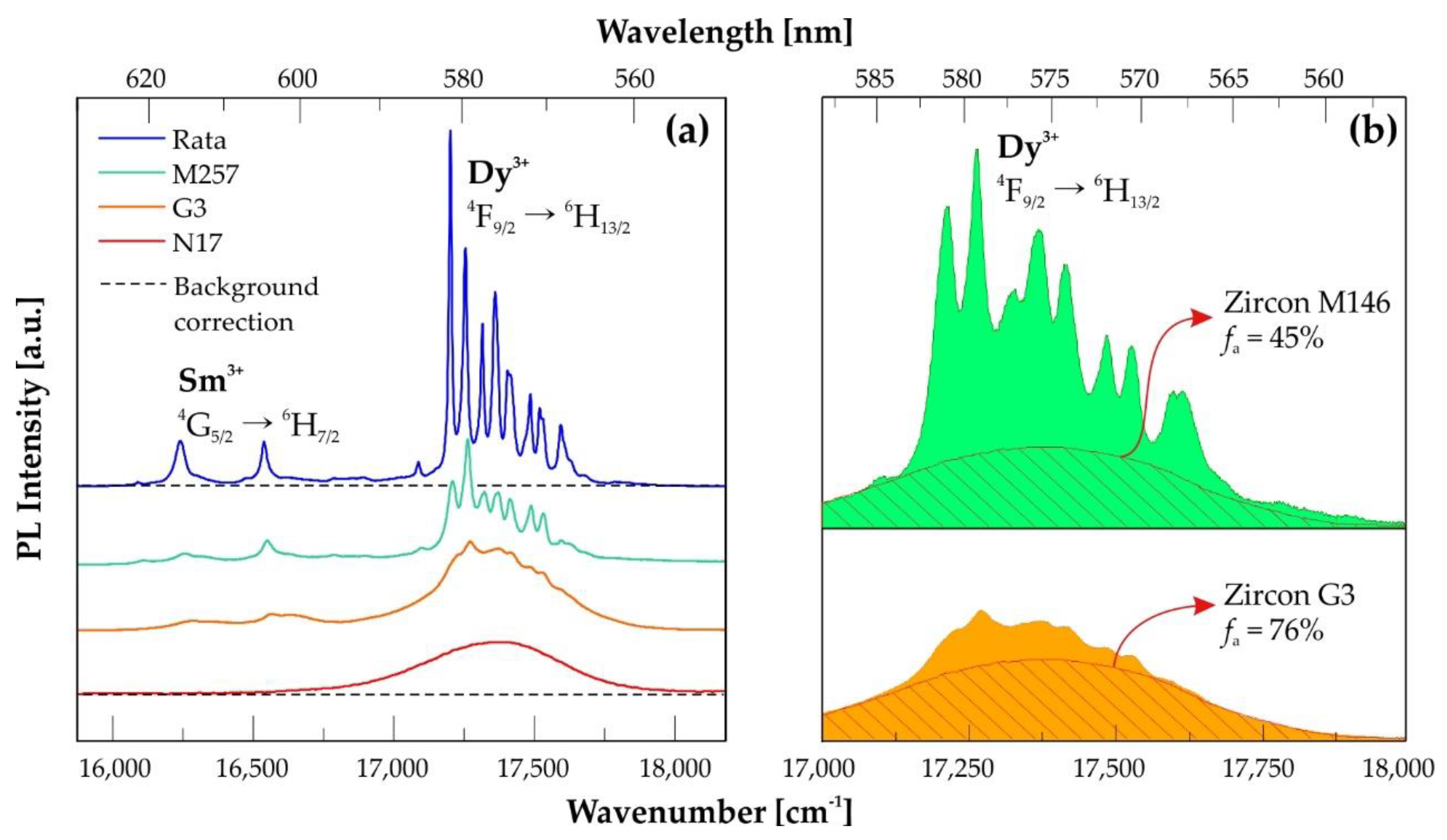
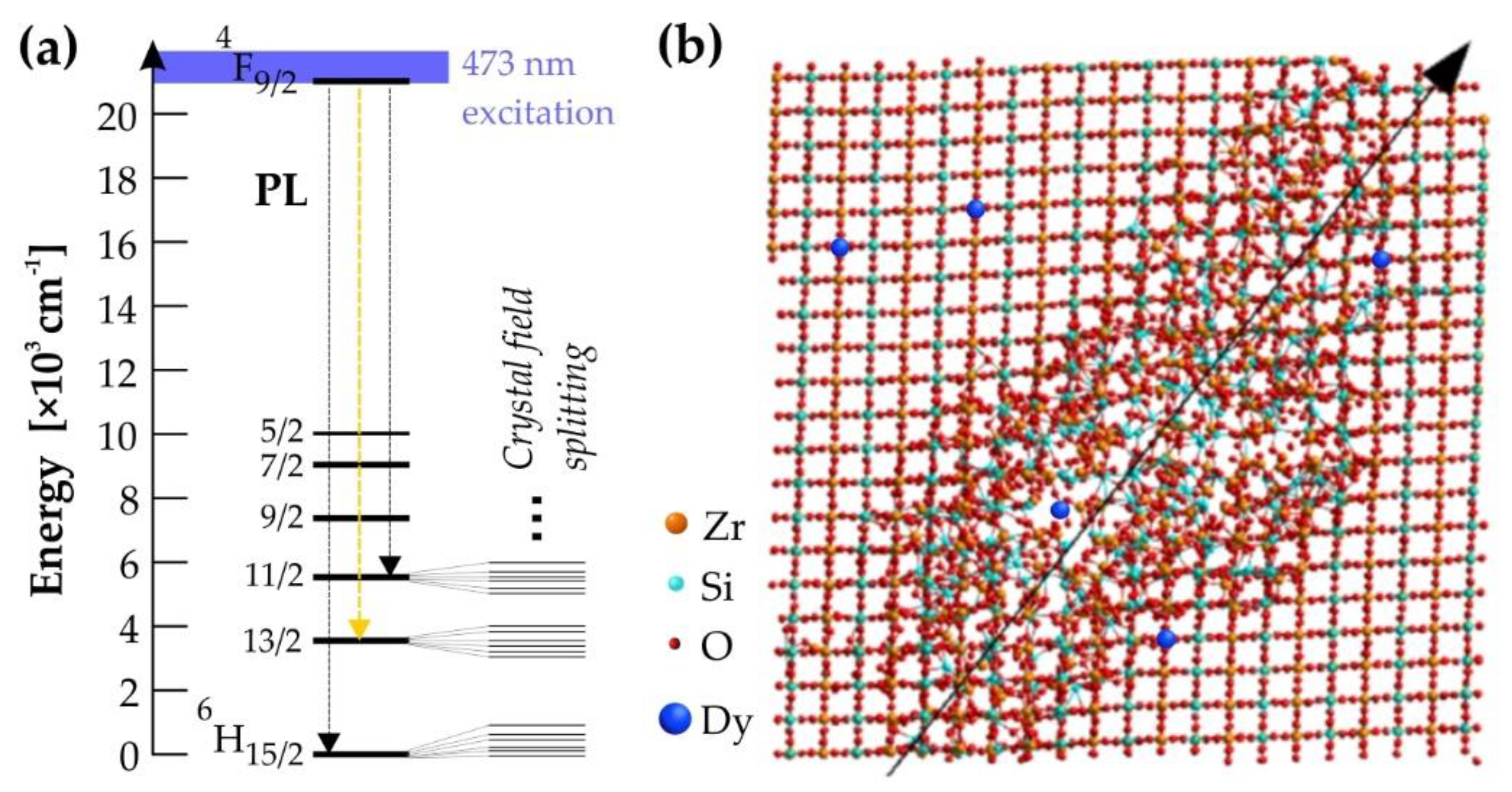
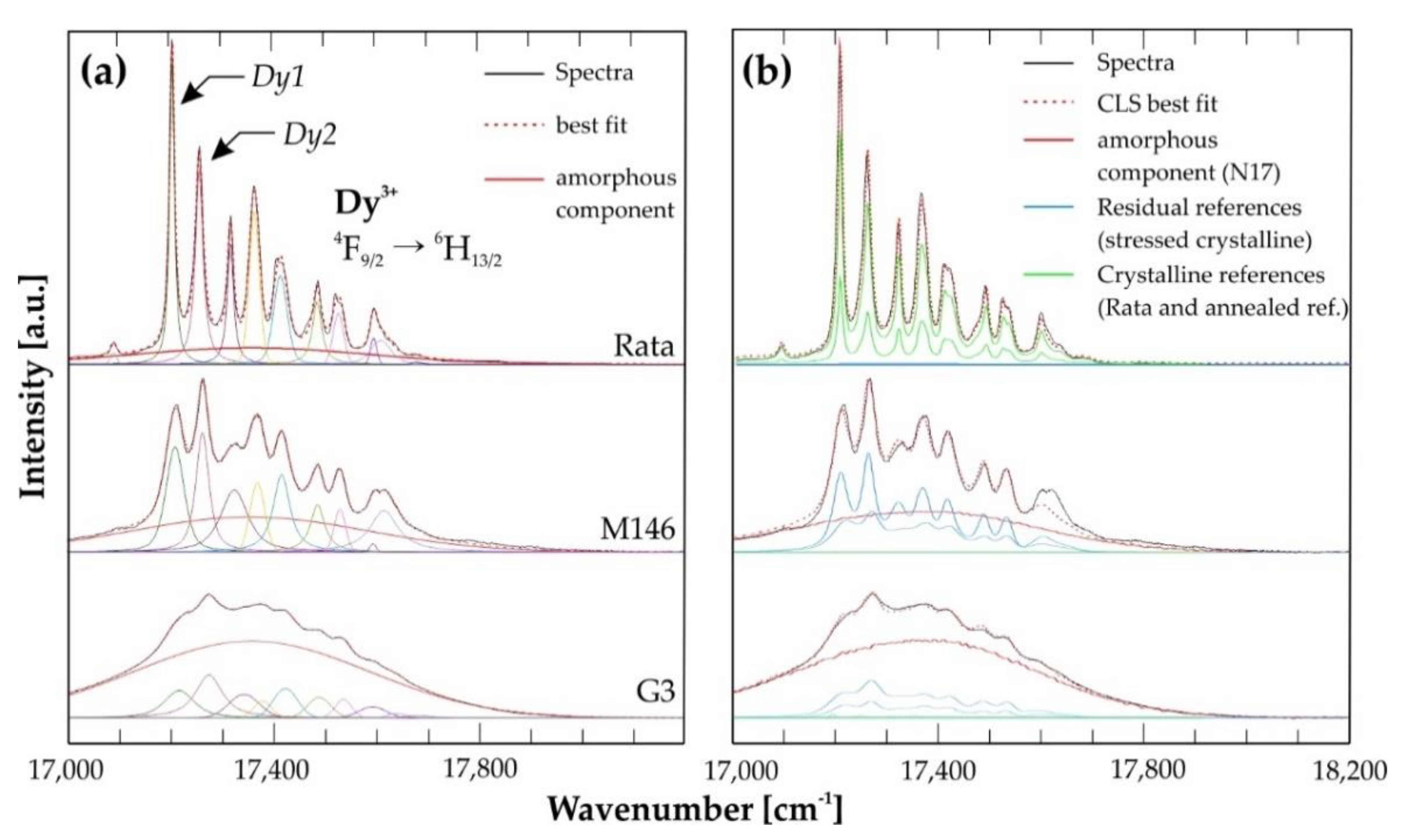

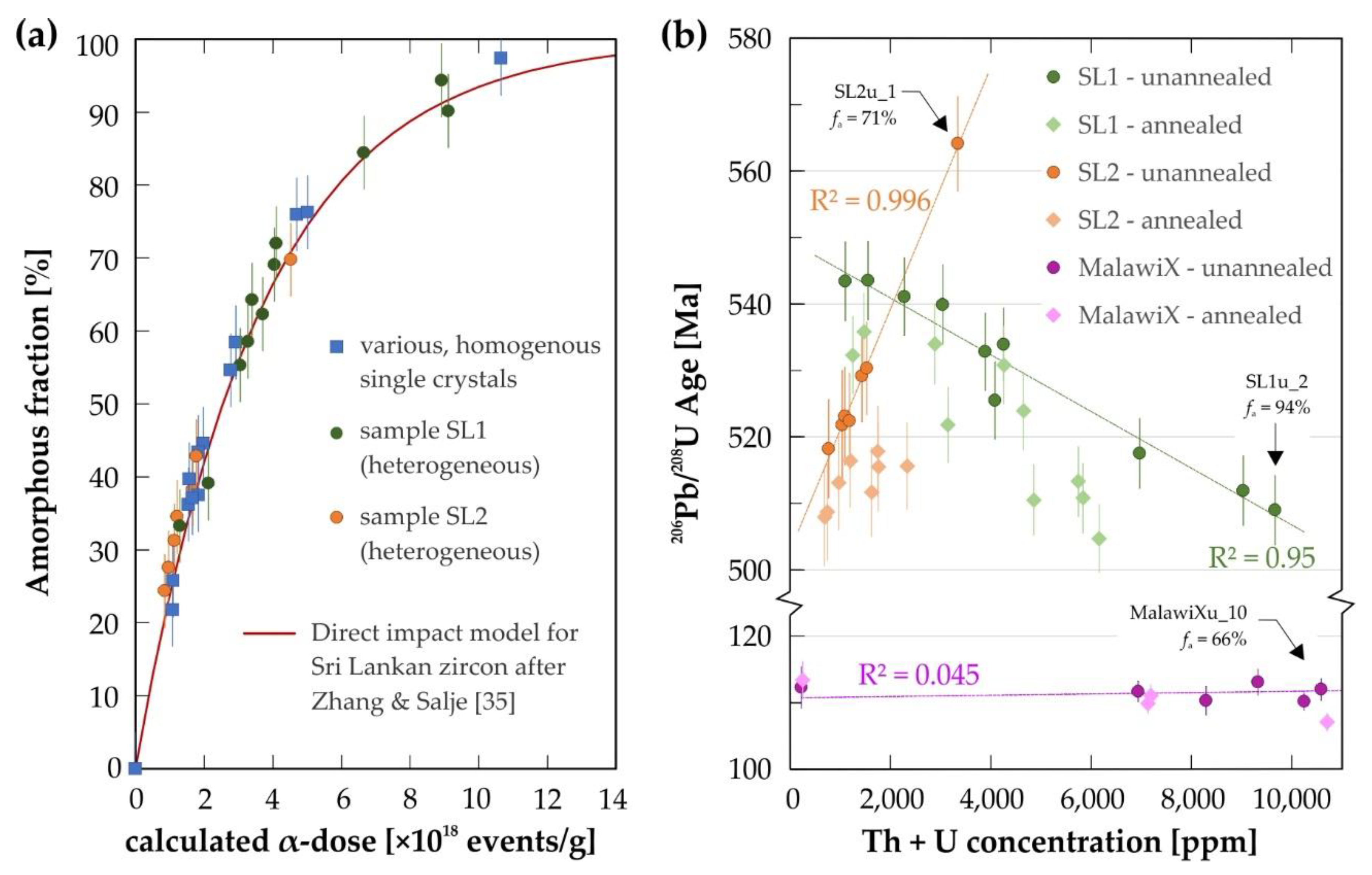
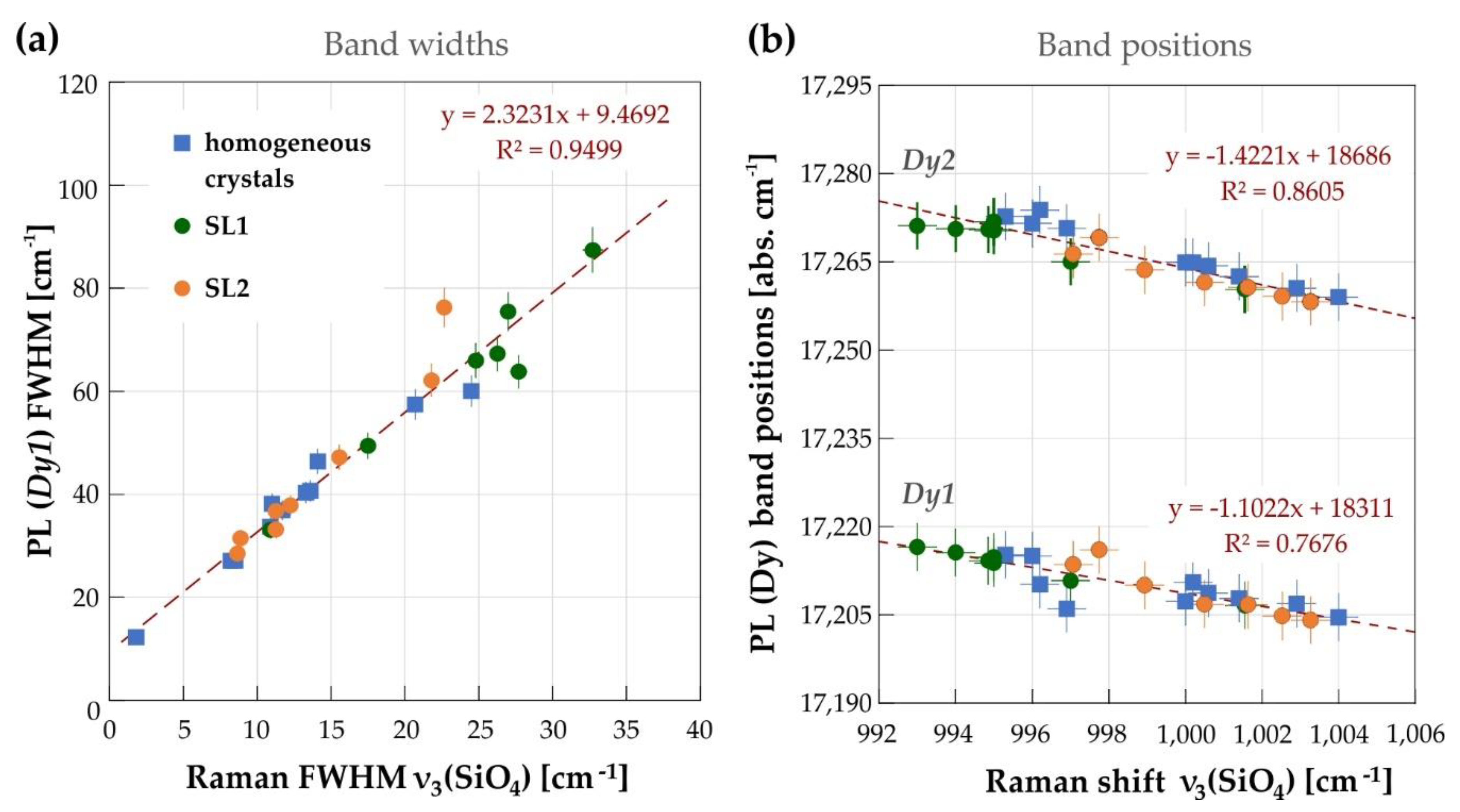
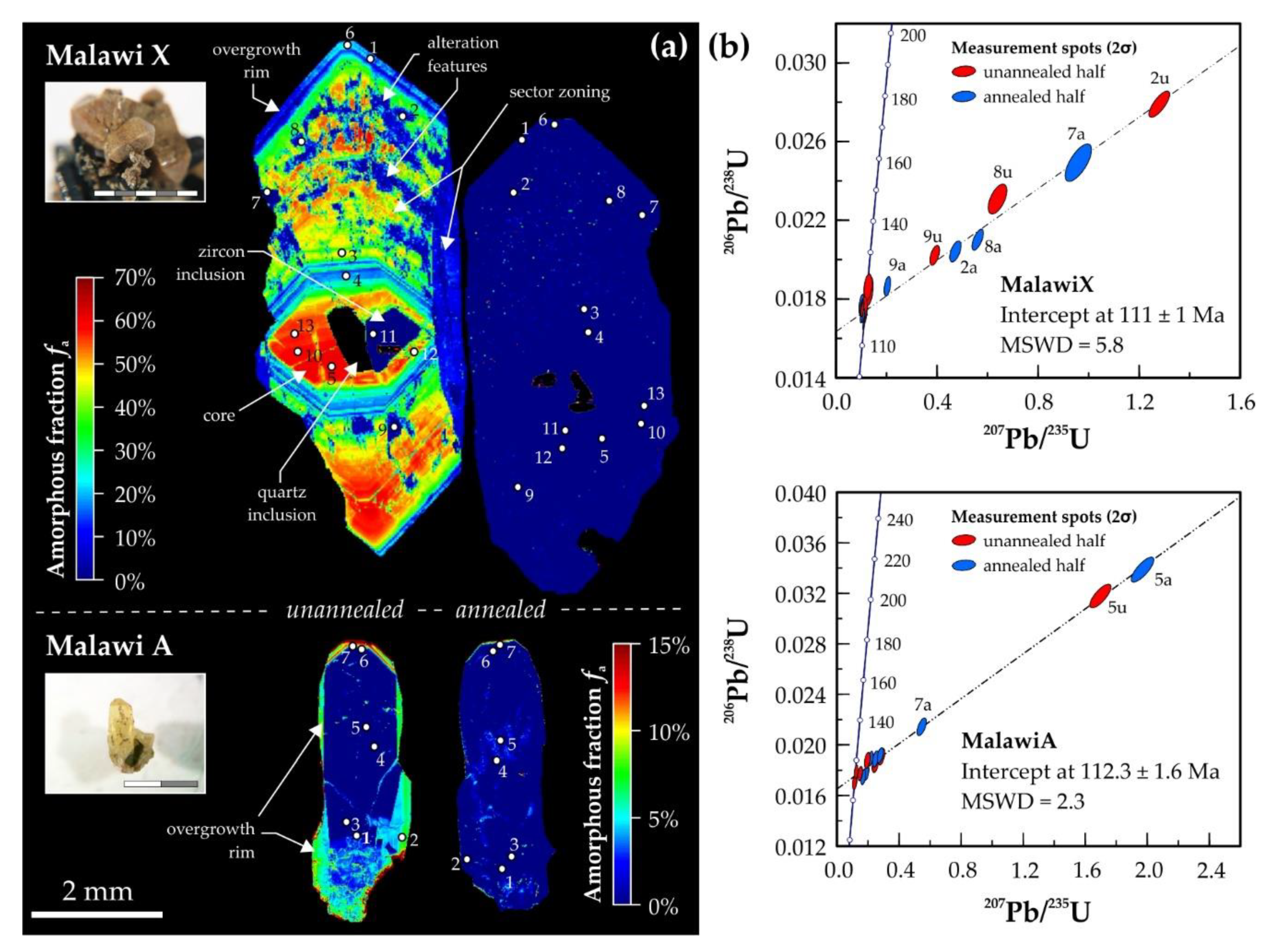

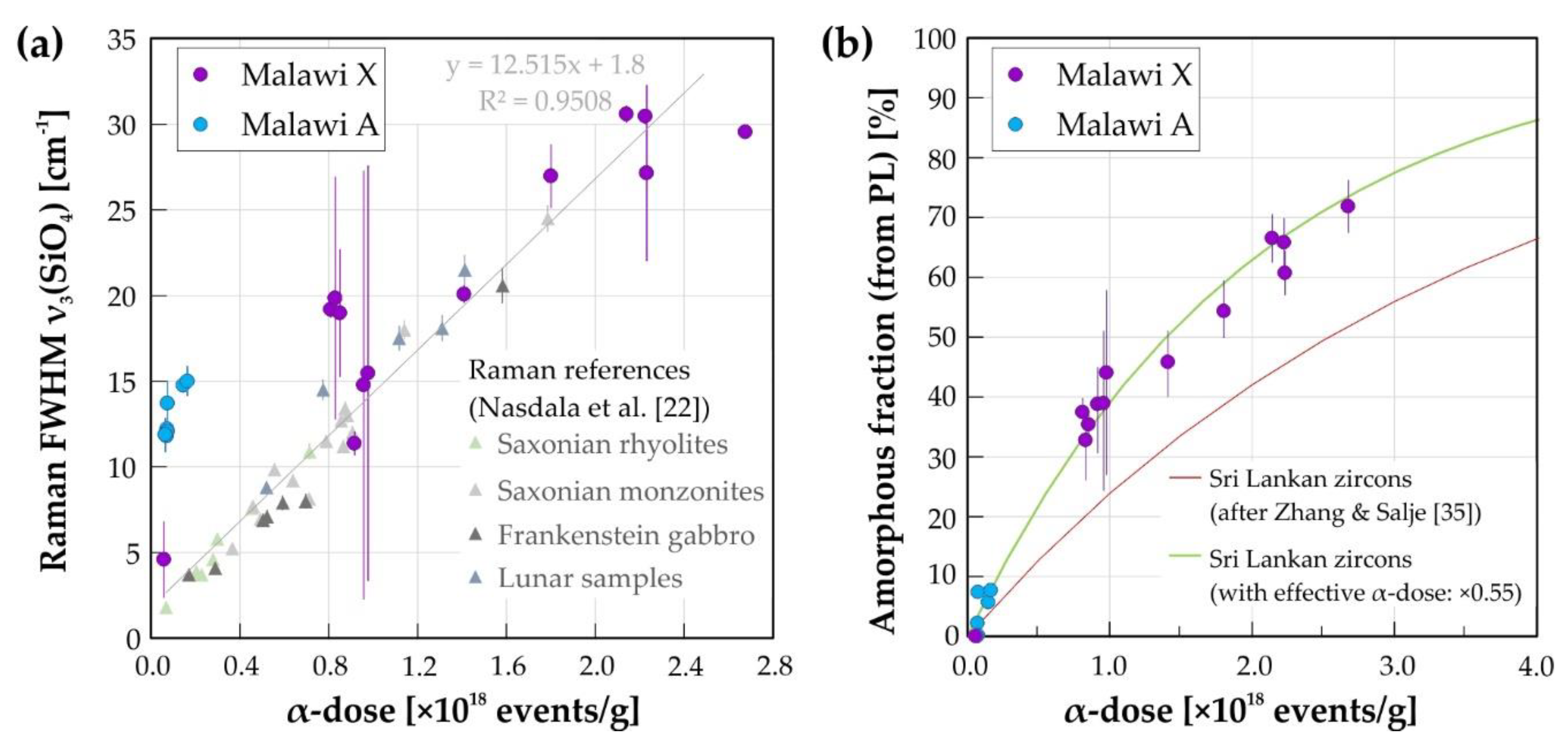
© 2020 by the authors. Licensee MDPI, Basel, Switzerland. This article is an open access article distributed under the terms and conditions of the Creative Commons Attribution (CC BY) license (http://creativecommons.org/licenses/by/4.0/).
Share and Cite
Lenz, C.; Belousova, E.; Lumpkin, G.R. The In-Situ Quantification of Structural Radiation Damage in Zircon Using Laser-Induced Confocal Photoluminescence Spectroscopy. Minerals 2020, 10, 83. https://doi.org/10.3390/min10010083
Lenz C, Belousova E, Lumpkin GR. The In-Situ Quantification of Structural Radiation Damage in Zircon Using Laser-Induced Confocal Photoluminescence Spectroscopy. Minerals. 2020; 10(1):83. https://doi.org/10.3390/min10010083
Chicago/Turabian StyleLenz, Christoph, Elena Belousova, and Gregory R. Lumpkin. 2020. "The In-Situ Quantification of Structural Radiation Damage in Zircon Using Laser-Induced Confocal Photoluminescence Spectroscopy" Minerals 10, no. 1: 83. https://doi.org/10.3390/min10010083
APA StyleLenz, C., Belousova, E., & Lumpkin, G. R. (2020). The In-Situ Quantification of Structural Radiation Damage in Zircon Using Laser-Induced Confocal Photoluminescence Spectroscopy. Minerals, 10(1), 83. https://doi.org/10.3390/min10010083





